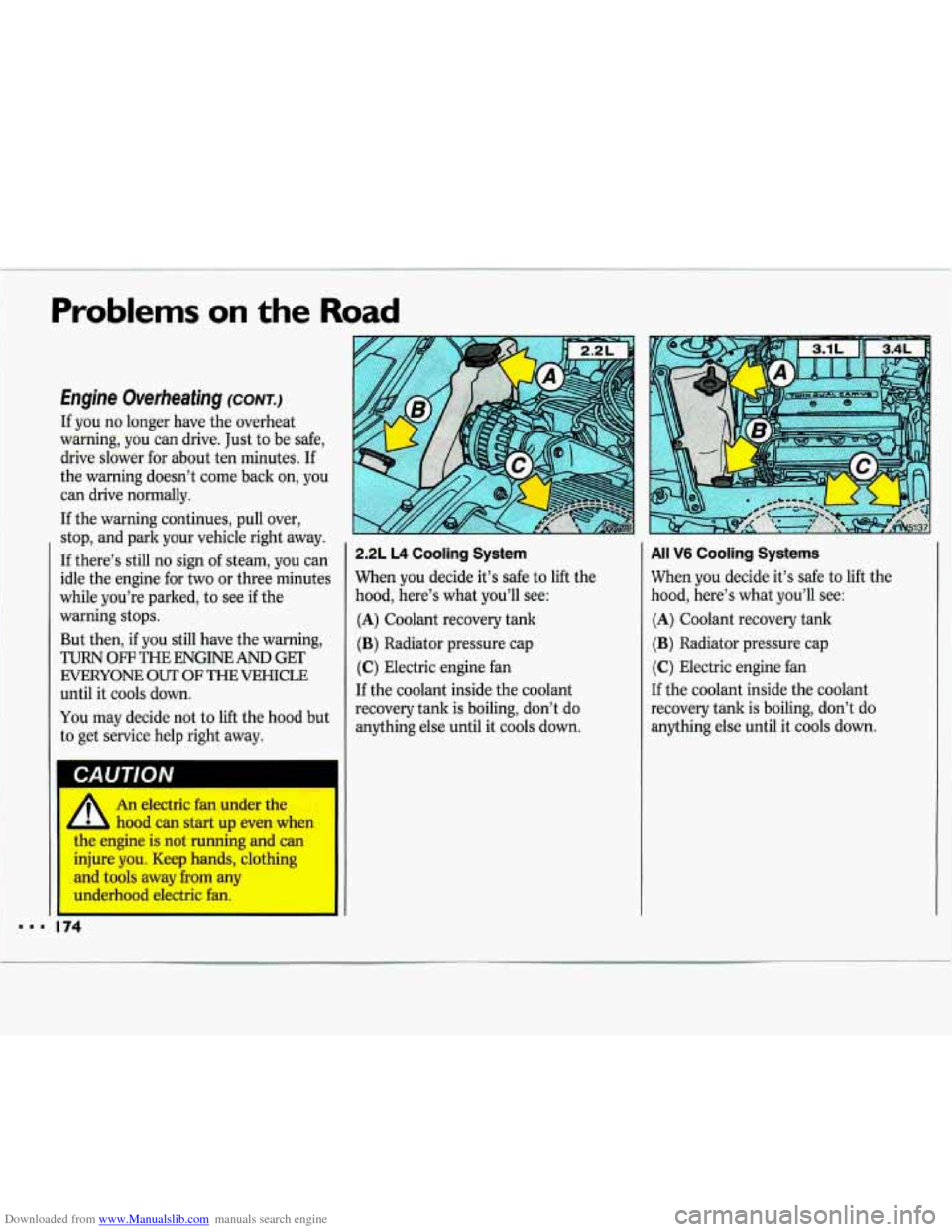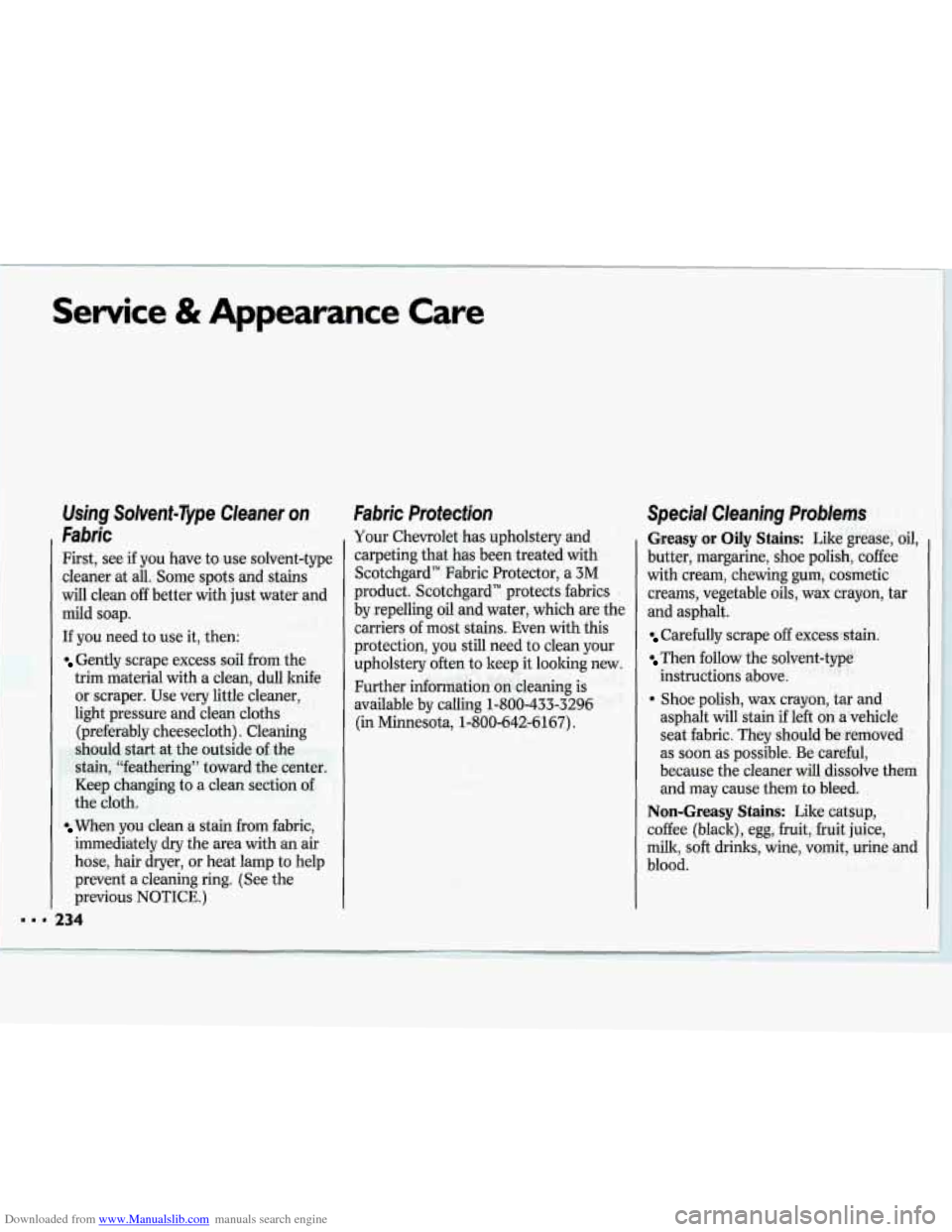Page 11 of 324
Downloaded from www.Manualslib.com manuals search engine These symbols are on some of your
controls:
Windshield Wipers
Windshield Washer
Windshield Defroster
Rear Window Defogger Ventilating Fan
Power Window
These symbols are used on warning and
indicator lights:
Engine Coolant
Temperature
'*Yi Battery Charging
Q I System
Engine Oil Pressure
3f
Brake
Anti-Lock Brakes
Here are some other symbols you may
see:
Fuse
Trunk Release
Lighter
Horn Speaker
Hood Release
Page 93 of 324
Downloaded from www.Manualslib.com manuals search engine Oil Warir;bg, Light
If you have: a problem with your oil, this
light may stay on after you start your
engine, or come on when you
ate
driving. This indicates that oil is not
going though your engine quickJy
enou.gh
to keep it lubricated. The
engine cadd below on oil, or could
have
some other oil problem. Have it
fixed right away.
V
A
Don’t keep driving if the oil
pressure is low.
If you do,
your engine can become
so hot that
it catches fire.
You or others could
be burned. Check your oil
as soon
as possible and have your vehicle
serviced.
NOTICE
91
Page 148 of 324

Downloaded from www.Manualslib.com manuals search engine Your Driving and the Road
‘I
Driving a long Distance
Although most long trips today are
made on freeways, there are still many
made on regular highways.
Long-distance driving on freeways and
regular highways is the same in some
ways. The trip has to be planned and
the vehicle prepared, you drive at
higher-than-city speeds, and there are
longer turns behind the wheel. You’ll
enjoy your trip more if you and your
vehicle are in good shape. Here are
some tips for a successful long trip.
I46
Before leaving on a Long Trip
Make sure you’re ready. Try to be well
rested. If you must start when you’re
not fresh-such as after a day’s work-
don’t plan to make too many miles that
first part
of the journey. Wear
comfortable clothing and shoes you can
easily drive in.
Is your vehicle ready for a long trip?
If
you keep it serviced and maintained, it’s
ready to go. If it needs service, have it
done before starting out. Of course,
you’ll find experienced and able service
experts in Chevrolet dealerships all
across North America. They’ll be ready
and willing to help
if you need it. Here
are some things you can check
before a trip:
Windshield Washer Fluid: Is the
reservoir full? Are all windows clean
inside and outside?
shape?
Have you checked all levels?
lenses clean?
Wiper Blades: Are they in good
Fuel, Engine Oil, Other Fluids:
Lights: Are they all working? Are the I
Tires: They are vitally important to a I
safe, trouble-free trip. Is the tread
good enough for long-distance
driving? Are the tires all inflated to
the recommended pressure?
weather outlook along your route? Should you delay your trip a short
time to avoid a major storm system?
Maps: Do you have up-to-date maps?
Weather Forecasts: What’s the
Page 176 of 324

Downloaded from www.Manualslib.com manuals search engine .- I
Problems on the Road
hgine Overheating (CONT.)
If you no longer have the overheat
warning, you can drive. Just to be safe,
drive slower for about ten minutes.
If
the warning doesn’t come back on, you
can drive normally.
If the warning continues, pull over,
stop, and park your vehicle right away.
If there’s still
no sign of steam, you can
idle the engine for two or three minutes
while you’re parked, to see
if the
warning stops.
But then, if you still have the warning,
TURN OFF THE ENGINE AND GET
EVERYONE
OUT OF THE VEHICLE
until it cools down.
You may decide not to lift the hood but
to get service help right away.
LAU I IVN
2.2L L4 Cooling System
When you decide it’s safe to lift the
hood, here’s what you’ll see:
(A) Coolant recovery tank
(B) Radiator pressure cap
(C) Electric engine fan
If the coolant inside the coolant
recovery tank is boiling, don’t do
anything else until it cools down.
All V6 Cooling Systems
When you decide it’s safe to lift the
hood, here’s what you’ll see:
(A) Coolant recovery tank
(B) Radiator pressure cap
(C) Electric engine fan
If the coolant inside the coolant
recovery tank is boiling, don’t do
anything else until it cools down.
I
Page 201 of 324
Downloaded from www.Manualslib.com manuals search engine 3.7L V6 Engine (CODE TOR w)
When you open the hood, you’ll see:
1. Power Steering Fluid Reservoir
2. Automatic Transaxle Fluid Dipstick
3. Brake Fluid Reservoir
4. Windshield Washer Fluid Reservoir
5. Battery
6. Air Cleaner
7. Engine Oil Fill Cap
8. Engine Oil Dipstick
9. Radiator Pressure Cap
10. Engine Coolant Reservoir
I99
Page 202 of 324
Downloaded from www.Manualslib.com manuals search engine Service & Appearance Care
= 200
W6119
Twin Dual Cam (DOHC) 3.4L V6
Engine (CODE X)
When you open the hood, you’ll see:
1. Power Steering Fluid Reservoir
2. Automatic Transaxle Fluid Dipstick
3. Brake Fluid Reservoir
4. Hydraulic Clutch Fluid Reservoir
5. Windshield Washer Fluid Reservoir
6. Battery
7. Air Cleaner
8. Engine Oil Fill Cap
9. Engine Oil Dipstick
IO. Radiator Pressure Cap
11. Engine Coolant Reservoir
(if equipped)
(if equipped)
Page 236 of 324

Downloaded from www.Manualslib.com manuals search engine Service & Appearance Care
Using Solvent-Type Cleaner on
Fabric
First, see if you have to use solvent-type
cleaner at all. Some spots and stains
will clean
off better with just water and
mild soap.
If you need to use it, then:
Gently scrape excess soil from the
trim material with a clean, dull knife
or scraper. Use very little cleaner,
light pressure and clean cloths
(preferably cheesecloth). Cleaning
should
start at the outside of the
stain, “feathering” toward the center.
Keep changing to a clean section of
the cloth.
When you clean a stain from fabric,
immediately dry the area with an air
hose, hair dryer, or heat lamp to help
prevent a cleaning ring. (See the
previous NOTICE.)
. 234
Fabric Protection
Your Chevrolet has upholstery and
carpeting that has been treated with
Scotchgard” Fabric Protector, a
3M
product. Scotchgard” protects fabrics
by repelling oil and water, which are the
carriers of most stains. Even with this
protection, you still need to clean your
upholstery often to keep it looking new.
Further information
on cleaning is
available by calling 1-800-433-3296 (in Minnesota, 1-800-642-6167).
Special Cleaning Problems
Greasy or Oily Stains: Like grease, oil,
butter, margarine, shoe polish, coffee
with cream, chewing gum, cosmetic
creams, vegetable oils, wax crayon, tar
and asphalt.
Carefully scrape off excessstain.
Then follow the solvent-typg
. Shoe polish, wax crayon, tar and
instructions
above.
asphalt will stain if left
on a vehicle
seat fabric. They should be removed
as
soon as possible. Be careful,
because the cleaner will dissolve them
and may cause them to bleed.
Non-Greasy Stains: Like catsup,
coffee (black), egg, fruit, fruit juice,
milk, soft drinks, wine, vomit, urine and
blood.
Page 271 of 324

Downloaded from www.Manualslib.com manuals search engine ITEM
NO. SERVICE
6 Camshaft Timing Belt Inspection (3.4L Code X
engine only)*-Inspect for cracks, wear or oiliness.
Check tensioner for proper operation. See the
service manual.
(To purchase a service manual,
see the
Index under Service Publications.)
Replace parts as needed.
Cooling System Service*-Drain, flush and refill
the system with new or approved recycled coolant
conforming to
GM Specification 1825M. Keep
coolant at the proper mixture as specified. See the
Index under Coolant. This provides proper freeze
protection, corrosion inhibitor level and engine
operating temperature.
7
8
Inspect hoses and replace if they are cracked,
swollen or deteriorated. Tighten screw-type hose
clamps. Clean the outside of the radiator and air
conditioning condenser. Wash the pressure cap
and neck.
To help ensure proper operation, we recommend a
pressure test of both the cooling system and the
pressure cap.
Transaxle Service-For manual transaxles, fluid
doesn’t require changing.
For automatic transaxles, change both the fluid
and filter every 15,000 miles (25
000 km) if the
vehicle is mainly driven under one or more
of
these conditions:
ITEM
NO.
9
10
11
SERVICE
In heavy city traffic where the outside
temperature regularly reaches
90°F (32°C) or
higher.
In hilly or mountainous terrain.
When doing frequent trailer towing. (With some
models you shouldn’t ever tow a trailer. See the
Index under Towing a Trailer.)
Uses such as found in taxi, police car or delivery
service.
If you do not use your vehicle under any of these
conditions, change both the fluid and filter every
100,000 miles
(160 000 km).
Spark Plug Replacement*-Replace spark plugs
with the proper type. See the
Index under
Replacement Parts.
Spark Plug Wire Inspection*+Inspect for
burns, cracks
or other damage. Check the boot fit
at the coils and at the spark plugs. Replace wires
as needed.
Positive Crankcase Ventilation System
Inspection*-Inspect system for proper function.
Replace any
worn, plugged or collapsed hoses or
seals. Replace valve only if necessary.
269 .